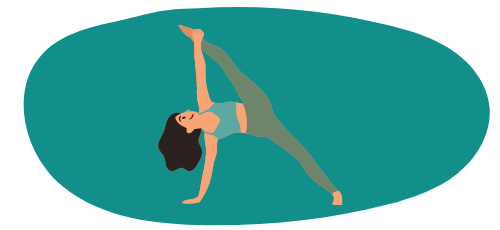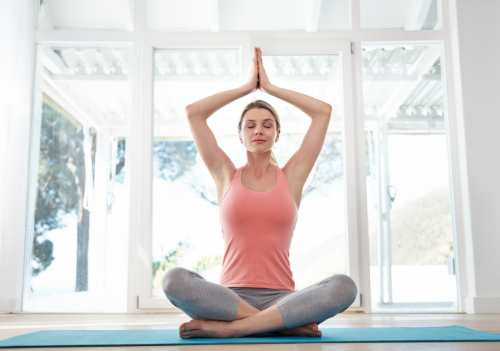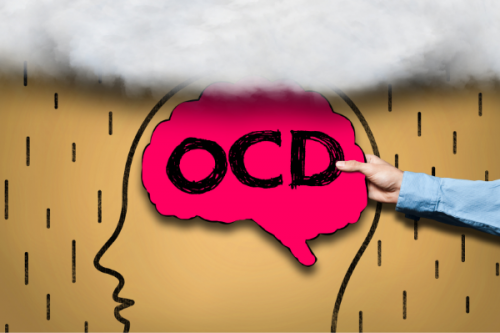105 Utterly Amazing Benefits of Yoga
If you want to see the all of the benefits of yoga in one place, then you’ll LOVE this guide!
We’ve scoured scientific studies, papers, medical journals, and more to provide 105 scientifically backed benefits of yoga.
I don’t want to bore you with the details, so keep on reading to learn these amazing benefits.
Check it out:
Yoga Fitness Benefits
When you think of yoga, you often think of flexibility and calmness. Ohmmmmm….
Did you know that yoga can actually improve your strength? Give you better control of your muscles? Make you say, ohmmm?
Read on for more amazing fitness benefits!
1. Improves Strength
Many people think only of the flexibility benefits inherent in yoga. However, in a study conducted over 12 weeks where participants completed daily yoga sessions, muscular strength was found to have increased[1] as well.
This increased strength is due to the fact that yoga requires incredible amounts of muscular control in order to hold positions for extended periods of time.
2. Increases Proprioception “Muscle Control”
Proprioception, or awareness of where your body is in space, has been found to improve with yoga practice.
In a research study[2] involving a group of blind children, who need to rely on their proprioceptive abilities more than do those who have normal visual abilities, it was found that the practice of yoga had a beneficial effect on body awareness.
3. Emphasizes Core Strength
Athletes, people with back, pain, and every day individuals can all benefit from increasing their core strength.
A review from 2018[3] found that common yoga poses are extremely beneficial in increasing core strength in yoga practitioners.
The poses this study looked at in particular included: low plank, side plank, inclined plane, shoulder stand, and warrior. These poses are part of almost all yoga routines and are important to incorporate in every individual’s daily life and fitness plan.
4. Improves Muscle Tone
Yoga has been shown in many studies including a high-quality randomized control trial[4] to lead to weight loss. With weight loss often comes more defined muscles which are developing as these individuals are going through the yoga program.
The many muscular demands of yoga force the body to adapt and muscles look strong and toned after these individuals undertake a yoga program.
5. Ensures Balance Across Muscle Groups
Yoga places a lot of emphasis on working all of the muscle groups in the body.
This is important for health and athletic performance as, according to a study published in the Journal of Strength and Conditioning Research[5], agonist and antagonist muscles (opposing muscles) should be worked equally for optimal strength and power output.
6. Increases Range of Motion
It should come as no surprise that yoga increases range of motion in those that practice it regularly.
In a meta-analysis that looked at multiple studies of yoga’s effects in older adults, it was found that yoga significantly improved range of motion in these individuals[6].
But these positive increases in ROM are not limited to older adults, as studies have also found benefits for younger athletes[7], indicating that anyone can reap the benefits of yoga, regardless of age.
7. Improves Flexibility
One of the most intuitive benefits of yoga is that of increased flexibility, and the link between yoga and flexibility was clearly defined in a research study from 2016[8].
While this particular study was performed on athletes, the benefits of increased flexibility are great for anyone of any age or ability level.
8. Builds Endurance
It’s well known how important endurance is for overall health and heart health specifically.
While yoga typically emphasizes slow, methodic movement, one study found a surprising outcome in which yoga tended to improve cardiovascular fitness more than other aerobic exercise types[9].
While it isn’t completely clear why this was the case, the results are incredibly encouraging!
Yoga Coordination & Balance Benefits
Yoga is a great tool to help with coordination and balance.
The different poses put your body in new positions helping you gain better muscle control and developing often neglected muscles such as those in the feet in legs that help with balance.
Keep reading for more benefits:
9. Improves Balance
Good balance and stability are some of the best qualities that prevent falls in older and disabled individuals.
Additionally, balance and stability are important even for healthy individuals[10].
Yoga focuses heavily on balance and stability through the many different static and dynamic postures used throughout practice.
10. Makes You More Coordinated
Children who fall on the Autism spectrum often have delays and issues involving motor control and coordination.
Autism can be a debilitating condition which often leaves the child frustrated and the parents feeling hopeless. But yoga looks like it may be able to save the day once again.
Yoga has been found to improve coordination in these children[11], leading to decreased disability and improvements in all areas of life.
If it can work for children, it can work for you!
11. Strengthens Hand-Eye Coordination
Compared to other forms of physical exercise, it seems that yoga generates greater improvements in hand-eye coordination[12].
Coordination is generally thought of only in terms of sports. However, hand-eye coordination is important in everyday life and can be seen as a measure of overall health in adults and children alike.
It enables us to respond to unexpected occurrences and protect ourselves or perform other actions as necessary.
12. Increases Dexterity
Due to the incredibly strong mind-body connection built through yoga practice, dexterity[13] is often markedly increased in individuals who frequently perform yoga breathing and movement exercises.
This is an important finding as dexterity is an important skill for people of all ages when it comes to skills related to work and daily life.
13. Decreases Reaction Time
Yoga has been found to improve reaction time[14] in practitioners.
Reaction time is an important measurement that can determine whether or not we can defend ourselves from threats, stop ourselves from falling or getting injured, and generally keep us safe.
The fact that yoga has been shown to be effective for decreasing reaction time is excellent news for anyone looking for a natural way to improve their health and safety.
14. Improves Depth Perception
Yoga’s positive effect on proprioception[15] can lead to improved depth perception in dedicated practitioners.
Having a better awareness of where the body is in space is one of the best ways to achieve improved depth perception and will lead to improved coordination and all of the other important attributes that help us navigate through the world.
Yoga Heart Health Benefits
Previously, we attributed heart health benefits mostly to cardiovascular and strength training work outs.
But after some research, we found several studies showing the heart health benefits of yoga.
Yoga is zen for your heart!
15. Regulates Blood Pressure
A systematic review found that yoga is an effective method for reducing blood pressure[16] in hypertensive patients.
The combination of intentional movement, meditation, and focused breathing all led to healthier blood pressure readings in the individuals who participated in these studies.
With nearly 80 million people in the U.S. alone having diagnosed hypertension, yoga might be one of the best options to address this crisis.
16. Slows Pulse
Can yoga slow the practitioner’s pulse rate?
One study found that there was a difference between participant’s pulse rates with the use of yoga-based breath control[17].
This difference was not “statistically significant”, but it is worth noting that there does seem to be something to the theory of yoga assisting in slowing down the heart rate.
Future studies will be able to use these results, hopefully leading to new treatments and strategies for those who have uncontrollably high heart rates.
17. Improves Circulation
According to a literature review, yoga improves blood circulation throughout the entire body[18], enabling the nutrients inherent in our blood to reach all organs, muscles, and other tissues throughout the body.
Yoga poses are designed to fully engage our bodies, allowing them to heal and move as they were intended to.
With the number of people being diagnosed with circulation issues every day continuing to rise, it’s good to know that yoga can help to address the issue!
18. Decreases Breathing Rate
As is the case for the cardiovascular system, a slower respiratory rate is often a sign of a healthier body overall.
In one study, it was found that respiratory control was positively affected through yoga practice[19].
Even though this study did not conclude that the observed outcome led to an athletic advantage, it is interesting to note, and has wide implications in terms of treatments for lung issues and future research.
19. Improves Cardiovascular Endurance
Cardiovascular endurance is vital for athletes and average individuals alike.
While on the surface yoga may seem like it is too calm to build cardiovascular endurance, it was found to have significantly improved the measure in a 12 week study of adults in China[20].
The sustained poses and controlled breathing that are hallmark traits of yoga practice force the body to adapt and improve its cardiovascular capabilities.
20. Leads to Improved Heart Health
Heart disease is one of the leading causes of death in the United States today.
Therefore, tons of research has been conducted to determine the best way to combat this ever-evolving crisis.
One of the most risk-free ways to improve one’s heart health is to implement regular exercise into one’s routine.
A systematic review even found some evidence that yoga can help to improve the symptoms of heart disease in diagnosed patients[21].
Yoga Disease Risk & Symptom Reduction Benefits
As you’ve seen, yoga has a myriad of health benefits.
And these benefits compound on each to help reduce disease risk by keeping you active, flexible, and moving!
Yoga can also help alleviate symptoms from certain diseases.
Keep reading to learn more:
21. Lowers Risk of Heart Disease
Heart disease is one of the biggest health concerns in America today. Many risk factors can lead to heart disease such as obesity, stress, and lack of physical activity[22].
Over the years, studies have demonstrated the effect that yoga can have on heart disease because the practice increases physical activity, decreases stress, and can lead to weight loss[23].
By addressing all of these risk factors, yoga provides an excellent way for people to reduce their risk of heart disease.
22. Decreases Risk and Improves Symptoms of Osteoporosis
Osteoporosis is usually diagnosed based on a person’s BMD (Bone Mineral Density).
Multiple studies have found improved BMD scores as a result of both weight bearing and non-weight bearing yoga programs[24].
In fact, one study found that even as little as 12 minutes of yoga[25], performed daily, can reverse bone loss caused by osteoporosis.
23. Decreases Risk of Developing Alzheimer’s Disease
In a 2016 study[26], it was found that yoga may be as effective in preventing Alzheimer’s Disease-associated memory loss as MET (Memory Enhancement Training), the gold standard in treatment of the disease.
Additionally, some clinical trials[27] have found that yoga may positively influence depression symptoms in patients with Alzheimer’s Disease.
Many physical therapists and other professionals encourage the practice of yoga in patients with Alzheimer’s disease, and for good reason!
24. Is Helpful in the Treatment and Prevention of Diabetes
Yoga has been found to help in both the treatment and prevention of Type II Diabetes Mellitus[28].
While exercise in general tends to help patients improve their glucose tolerance and insulin sensitivity, yoga specifically aids in this process through the use of mindfulness and stress reduction techniques which activate the parasympathetic nervous system.
25. Relieves Symptoms of Carpal Tunnel Disease
One study[29] found that a yoga program was more effective for the treatment of carpal tunnel disease than was a wrist splinting program or no intervention.
The study found significant improvements in grip strength and pain reduction from baseline measures after the study participants completed a twice weekly yoga program for 8 weeks.
26. Reduces Symptoms of Asthma
Early findings from a small study suggest that dedicated yoga practice may reduce asthma symptoms[30] in disease sufferers.
Significant improvements were found in peak expiratory flow rate (PEFR) and study participants reported decreased incidence of asthma attacks as well as decreased reliance on asthma medication.
While larger studies are needed to confirm the findings, the early evidence of yoga’s effect on asthma symptoms is very promising.
27. Decreases Arthritis Symptoms
A systematic review conducted in 2011[31] found that arthritis (both RA and OA respectively) sufferers consistently reported improvement of symptoms as a result of the completion of a yoga program.
Not only did the individuals in these studies experience decreased disease symptoms, they also experienced significant improvement in mental health.
28. Improves Function in People with MS
From studying various “biomarkers” or indicators in patients who suffer from Multiple Sclerosis, it has become increasingly clear that yoga has a positive impact on overall health[32] for these individuals.
While further research is needed to determine exactly how yoga helps patients with MS specifically, early data is quite promising.
29. Increases the Quality of Life in Patients with Cancer
Through decreased stress and improved relaxation[33], yoga has been found to significantly help patients with breast cancer in terms of quality of life.
Breast cancer specifically has been a major focus of many studies, however, this does not mean that people suffering from other forms of cancer will not benefit from yoga as well.
Yoga practice is frequently recommended for cancer patients and is mentioned as one of the best ways to cope with the side effects of cancer by the company Cancer Research UK[34].
30. Improves Physical Function in Patients with Muscular Dystrophy
In children diagnosed with DMD or Duchenne Muscular Dystrophy, one of the most common causes of death is due to cardiovascular issues.
Therefore, the researchers used HRV (heart rate variability) as a measure of cardiovascular performance when they studied how patients with muscular dystrophy responded to a yoga program.
The results were very encouraging, as HRV improved in the study group that performed yoga[35].
31. Reduces Scoliotic Curvature
Through the daily performance of a side plank held for as long as possible, a group of 25 individuals were able to significantly reduce the angle of their scoliotic curve[36].
The results of this small study are promising and indicate that a comprehensive yoga program which would further stretch tight tissues in patients with scoliosis may lead to even better outcomes.
32. Improves Symptoms of Chronic Bronchitis
Over a period of 4 weeks, 15 patients were instructed in a yoga program that focused on flexibility, breath control, and mindfulness-based yoga.
At the end of the study, it was found that, on average, the patients experienced improvement in lung function[37] as measured by VC (Vital Capacity), FEV1 (Forced Expiratory Volume), and PEFR (Peak Expiratory Flow Rate).
33. Can Serve as an Adjunct Treatment for Epilepsy
Patients who suffer from epileptic seizures may not benefit directly from yoga treatments, but in a review of studies from 2017[38], it was found that patients with epilepsy reported improved quality of life from having completed a yoga program.
The reduced stress and anxiety that results from yoga practice is extremely beneficial for patients with epilepsy and further research is needed to determine how best to incorporate yoga into a complementary program for epilepsy sufferers.
34. Decreases Symptoms of OCD
Yoga that focuses heavily on meditation seems to have a beneficial effect in patients with Obsessive Compulsive Disorder.
While there is little research available on the subject, it appears that OCD symptoms tend to decrease with consistent yoga practice[39], especially forms of yoga that incorporate meditation such as Rajyoga meditation.
35. Reduces Migraine Severity and Frequency
For those who have never experienced a migraine, it can be hard to imagine just how painful they are.
Luckily, research shows that patients who perform yoga for 5 days a week for at least 6 weeks demonstrate decreased intensity and frequency in their migraine symptoms[40].
The study found that while the “conventional” migraine care was effective for migraine relief, conventional care combined with yoga therapy results in much better outcomes for migraine sufferers.
Yoga Longevity Benefits
Sometimes, we just want to stop the train and stop getting older.
Yoga can’t stop the train, but maybe yoga can slow it down.
Yoga has been shown to have several longevity benefits.
If you want to beat ageing, perhaps adding in a yoga routine is the right path!
36. Decreases Injury Risk
Injuries are tough to come back from. This is why the common phrase: “the best injury is the one that can be prevented in the first place” is applicable in so many scenarios.
Yoga has been found to prevent injuries in athletes[41] by addressing the “perception of propensity to sustain injury” as well as the fatigue that comes with high level athletic demands.
Basically, it seems that yoga prepares the body and mind for whatever life throws at them!
37. Enhances Parasympathetic Nervous System Activity
Within our bodies, the sympathetic and parasympathetic systems control our automatic processes.
Things like fight or flight responses and high energy activities are partially controlled by the sympathetic nervous system, while things like digestion and rest are left to the parasympathetic system.
Yoga has been found to improve autonomic regulation in both males[42] and females[43], allowing us to better control our parasympathetic responses.
38. Provides a Low Risk Way to Access the Benefits of Exercise
While injuries do happen during yoga practice, with the guidance of a certified yoga instructor, proper warm up, and listening to the body’s needs, injury risk is low[44] with the practice of yoga.
The practice emphasizes slow, controlled movements and good instructors will only encourage participants to try more advanced movements when they are ready to do so.
The injuries sustained in yoga come when practitioners try movements that they are not yet ready for. So take your time, progress when you are ready, and enjoy all the benefits yoga has to offer.
39. Yoga Can be Performed Anywhere
With tons of yoga studios across the world, affordable pricing plans, and youtube videos, yoga can literally be performed by anyone, anywhere.
The nearly 16 million adults[45] who practice yoga in the U.S. are a mere fraction of those that perform yoga worldwide, and the number seems to be growing daily as more and more people discover the benefits yoga has to offer.
40. Has Anti-aging Properties
Anti-aging is a popular topic for podcasts, news sources, and others across the world.
We all want to know how we can slow down or reverse the effects of time.
While there doesn’t yet appear to be a way to rewind the clock on aging, there do seem to be ways to slow down the impact of time on our bodies[46], and one such way is yoga and meditation.
41. Protects Joints and Cartilage
The process of joint and cartilage breakdown still seems to be impossible to reverse.
However, it does appear that we can slow down the devastating process and its effect on our function through the implementation of a yoga program[47].
Additionally, functional movements such as walking seem to improve with yoga, regardless of the extent of cartilage damage.
42. Keeps Your Spine Healthy and Flexible
The entire spine benefits from yoga practice from the neck[48] to the low back[49].
The combination of rotation, side bending, forward bending, and backward bending specific to yoga practice allow the spine to move in ways it typically isn’t able to throughout the day.
This creates a healthier, more durable spine over time.
43. Improves Bone Health
Both weight bearing and non-weight bearing exercises[50] specific to yoga seem to have positive effects on bone mineral density.
The weight bearing exercises improving bone mineral density makes perfect sense.
What is puzzling, but undoubtedly an excellent outcome, is that non-weight bearing yoga exercises also seem to improve bone mineral density to a similar level as weight-bearing exercise.
This has wonderful implications for anyone suffering from osteoporosis, osteopenia or even just for those who want to prevent themselves from developing any conditions related to bone loss.
Yoga Overall Health Benefits
We’ve already seen how yoga can benefit some specific health conditions, improve fitness and flexibility, and decrease the risk of some diseases.
Here are a bunch more overall health benefits that yoga practitioners enjoy!
44. Relieves Constipation
Studies have focused on yoga as a treatment for children with irritable bowel syndrome and other related issues.
While there is no definitive data to say that yoga is an appropriate treatment for these gastrointestinal issues[51], there is promising preliminary data[52] that demonstrates yoga’s positive effect on digestive problems such as IBS and constipation.
45. Reduces Allergy Symptoms
For allergy sufferers, every day can be a struggle.
While the sunshine and warm air may be tempting, they have to weigh the risk of going outside and suffering from an allergy attack.
Fortunately, there is some research showing that yoga can help to reduce allergy symptoms[52].
More research is needed, but this early research will pave the way for future studies in showing how yoga can be used to treat issues affecting the airways and nasal passages.
46. Helps Manage Menopausal Symptoms
Menopause can be a difficult experience for many women.
Not only are the physical symptoms difficult to deal with, the mental and emotional issues can be equally detrimental.
Yoga and meditation have been preliminarily found to reduce some of the mental stress[53] associated with menopause.
This is encouraging news, as many women worry about the menopausal stage of life and struggle with the transition.
Further research will help to define the exact ways in which yoga helps with this process as well as outlining which types of yoga and meditation are best for this population.
47. Improves Health of Internal Organs
Through yoga’s ability to help us control our parasympathetic nervous system[54], it’s many positive effects on our body as a whole, and the way it aids in issues with our gastrointestinal system[55], it’s no wonder that yoga is helpful for the health of internal organs.
Yoga brings us greater awareness of our body processes and allows us insight into any minor changes that may be indicative of disease.
Hopefully, with further research, this will push more doctors to prescribe yoga for their patients.
48. Fine-tunes Gastrointestinal Function
Yoga practitioners tend to have better control over their GI system and better GI health overall.
While it’s unknown exactly how yoga affects the GI system on a physiologic level, it has been theorized that the practice positively influences the “brain-gut axis[56]” and leads to improvement in GI health through this channel.
49. Strengthens the Immune System
One of the most important features of health is a strong immune system.
Luckily, yoga is an excellent way to strengthen the immune system and was found through a study to help the body resist the damage to cellular immunity caused by stress[57].
This is an incredibly important finding, as stress can negatively impact our lives in so many ways.
50. Increases Energy Levels
The practice of yoga has been found to improve both brain function and energy level[58].
This is excellent news in a time when more work needs to be done in shorter time frames.
While you may still reach for that morning cup of coffee or tea, it’s nice to know that yoga can lead to a rejuvenating and awakening feeling in those who regularly practice.
51. Improves Quality of Sleep
Yoga has such a beneficial effect on the mind and body that it can even improve the quality of our sleep when the practice is performed regularly.
In fact, when compared alongside natural supplements and chiropractic care, yoga was the better option in terms of improved sleep[59].
Sleep is incredibly important to overall health and yoga can help us get the most out of the hours we spend in our beds, away from all the stresses of the world.
52. Lowers Cholesterol Levels
In people with hypercholesterolemia, diabetes, and other diseases, high cholesterol levels can be extremely dangerous and is considered a risk factor for cardiovascular events such as strokes and heart attacks.
Thankfully, yoga is an easy-to-implement option that has been shown to decrease cholesterol levels in individuals who were diagnosed with type II diabetes[60] and were experiencing high cholesterol.
53. Improves Lymphatic System Function
One of the most common issues with the lymphatic system occurs in individuals with breast cancer.
These patients may develop lymphedema and will require a method of drainage to address the excess fluid that accumulates.
Yoga has been found to be an excellent tool for helping to address lymphedema in breast-cancer-related-lymphedema or BCRL[61].
54. Controls Blood Glucose Levels
For those diagnosed with type II Diabetes Mellitus, it is vitally important that blood glucose levels are monitored and kept within a healthy range.
Falling outside of the acceptable range can lead to mental confusion, dizziness, and in the worst cases death.
Yoga can help to control blood glucose levels in prediabetic and diabetic patients[62].
55. Improves Sodium and Electrolyte Balance
Because yoga can be a very demanding form of exercise that causes extreme sweating, your body is forced to be more efficient with regards to electrolyte balance when you regularly participate in yoga practice.
In onstudy, participants lost nearly 1.5L of sweat[63] during a single session of Bikram yoga.
While sweating it out is good, it’s important to make sure that you eat a good meal and drink plenty of water to help balance out this sweat loss through yoga.
56. Improves Endocrine Function
Many of the processes in our bodies are controlled by hormones which are regulated by the endocrine system.
In disease processes such as diabetes, endocrine control is incredibly important and yoga helps these patients control their glucose levels[64].
More and more, we are finding yoga to be beneficial as an adjunct treatment for diseases of the endocrine system.
57. Lowers Triglyceride Levels
Triglycerides are the basic components of fats[65] within our bodies.
When there are too many triglycerides circulating in our blood, it can lead to increased risk of disease and many other issues.
Yoga has been found to help patients control their lipid levels[66] by increasing exercise and decreasing stress in these patients.
58. Increase Red Blood Cell Count
Exercise tends to create an increase in red blood cells.
Yoga specifically, has been found to improve white blood cell, platelet, and red blood cell count[67] in practitioners.
More red blood cells allow us to work harder for longer by providing more oxygen to our cells.
This is encouraging information for athletes and average individuals who want to improve their endurance.
59. Raises Vitamin C Levels
Vitamin C has many benefits, including protection against immune deficiencies, cardiovascular disease, and eye disease. It has also been shown to help prevent skin wrinkling!
It has been shown that oxidative stress can lead an increase in free radicals which can neutralize Vitamins A, C, and E and even further exacerbate disease.
A 2018 study has shown that regular practice of yoga can lead to reduced fat and oxidative stress[68].
Lowering oxidative stress, will not only increase Vitamin C levels, but also Vitamins A & E.
60. Improves Lung Function
Yoga encourages deep, mindful breathing, which forces the lungs to expand and contract every time.
It has been found that yoga’s emphasis on breathing, along with the demand of the practice itself, can lead to improved lung function in patients with coronary artery disease[69].
While many studies have focused on yoga’s effect on lung function in patients with disease, the practice is beneficial for anyone who wants to improve their breathing capabilities.
61. Improves Digestion
Yoga is so effective in improving irritable bowel syndrome that it has even been suggested as a standalone treatment for the condition[70].
Irritable bowel syndrome can significantly improve quality of life in patient’s who are afflicted with the disease by increasing digestive system function and decreasing the various symptoms that go along with the condition.
62. Lowers Cortisol Levels
Cortisol is the stress hormone produced by the adrenal glands within our bodies. It is an important hormone for times of emergency, where we need to act and make quick decisions. But when cortisol is flowing through our systems for a long time, it causes all sorts of problems. Yoga has been reported as a potential way to reduce cortisol levels[71] and in turn, reducing stress and depression symptoms.
63. Improves Health of Skin
Through Happy Face Yoga, a facial exercise regimen, patients have seen improvement in the health and youthful appearance of their skin[72].
While it remains to be seen whether or not we will ever find the Fountain of Youth that will allow us to fully reverse the effects of aging, yoga seems to be a pretty good substitute for the time being!
We’ve seen previously that yoga can help lower oxidative stress, also helping with less wrinkles.
64. Helps with Hangover Symptoms
After a night out and one too many drinks, you may wake up with a pounding headache and wonder why you ever decided to put so much alcohol in your body.
Luckily, yoga can help with symptoms of a hangover such as headaches[73].
While it is still a good idea to reach for the water bottle when you wake up with a hangover, you might also consider heading out the door and getting to a yoga class as well to help you recover.
65. Strengthens the Mind-Body Connection
Yoga has been found to improve the function and structure[74] of many different areas of the brain.
With a practice that heavily emphasizes breathing, meditation, and movement, it’s hard to see how yoga wouldn’t help with almost every ailment in both the mind and the body.
Combining the practices of meditation and movement brings these two systems together and results in a healthier, happier practitioner.
66. Improves Breathing Efficiency
Compared with those who don’t regularly perform yoga, practitioners have been found to consume nearly 15% less oxygen[75] throughout the day.
This allows them to be more efficient with their use of oxygen and would theoretically improve their chances of surviving in conditions where there was less oxygen available to them.
67. Allows for Greater Breathing Control
Many forms of yoga emphasize deep, controlled breaths as part of the practice.
These breathing techniques force practitioners to focus on what is usually an automatic process and encourages a connection between the nervous system and the pulmonary system[76].
This allows those who regularly perform yoga to translate these breathing skills to other aspects of life, providing a calming and healthy stimulus to the body at all times.
68. Provides a Non-Competitive way to Obtain the Benefits of Exercise
While many forms of exercise and various sports are focused on personal and peer competition[77], yoga’s major focus is on enabling practitioners to achieve a stress-free state while they exercise and become healthier, happier versions of themselves.
Yoga encourages everyone to attempt to relax as much as possible as they move through the various postures and stretches involved in the session, making it an excellent choice for people looking to avoid a stressful form of exercise.
69. Releases Muscle Tension
At one point or another, you’ve probably noticed your shoulders, neck, hands or some other part of your body aching when you’ve been in a long-term stressful situation.
This is a natural stress reaction when life events feel like they are out of our control.
Yoga forces us to relax these muscles and encourages our bodies to let go of this stress, allowing the tension to slowly recede. Not only does yoga decrease muscle tension, it also leads to increased happiness in participants[78].
70. Increases Pain Tolerance
Chronic pain is a devastating condition that affects many people for many different reasons.
For people with chronic pain, it can sometimes feel like there is nowhere for them to turn to find relief. Fortunately for these individuals, yoga has been found to be effective for many of the issues associated with chronic pain[79].
71. Encourages Better Posture
Posture is a huge focus of yoga practice. Many yoga teachers will provide gentle cues to students that encourage them to correct their posture while holding various poses.
With practice, yoga can help to permanently improve posture and reduce the effects of musculoskeletal pain[80] and may even reduce injury risk.
Yoga Cognitive Performance Benefits
Yoga has brain power!
That’s right, with all these health benefits, yoga can help the brain, too.
From memory and concentration all the way to being more creative – yoga can help.
Below, we’ll outline all that we’ve learned about yoga and brain function:
72. Inspires Creativity
Knowledge and wisdom are incredibly important.
However, it tends to be creativity that really makes a genius stand out from his or her peers.
Many entrepreneurs have begun to tap into the power of yoga, which has been found to stimulate creativity[81]in those who practice it.
73. Sharpens Concentration
It can be hard to concentrate on anything these days with emails, text messages, phone calls, and news alerts all distracting us during the day.
Yoga allows us to better concentrate on the task at hand[82] while drowning out all other thoughts and stimuli that try to distract us from what we need to do.
74. Improves Memory
Yoga seems to have a beneficial effect on memory and cognition in general[83].
This is likely due to the fact that the breath control and movements characteristic of yoga encourage blood flow to the brain, which provides vital nutrients that allow the brain to thrive.
These early findings have important implications for brain and memory disorders such as Alzheimer’s Disease.
75. Allows for an Increased Attention Span
Yoga sessions force practitioners to focus on their breathing and movement throughout the entirety of the class.
Over the course of many yoga classes, this can lead to improved attention and focus in individuals who might otherwise have short attention spans.
This is an incredibly important finding, as parents of children with ADD and ADHD[84] struggle to find ways to help their children that don’t involve medication.
Yoga may be the answer!
76. Provides Mental Clarity
Many people who regularly practice yoga experience improved mental clarity as a result.
In fact, one survey found that nearly 86% of participants reported an improved sense of mental clarity[85] from having performed yoga as compared to their peers who do not practice.
This number is impressive, and is one of the many reasons why so many people continue to join yoga studios every day.
77. Builds Focus
For young children[86], it can be incredibly hard to focus on a specific task.
While this may be normal in some cases, in pathological situations where focus is decreased as the result of a disease process, sometimes parents and children alike can feel extremely frustrated and feel like they have few options to help address the issue.
Luckily, multiple studies are now finding the benefit of implementing yoga-based practices to help children focus on tasks.
78. Enhances Productivity
Mindfulness and meditation components of yoga can improve productivity[87] in workers, according to a study from 2017. With workers becoming increasingly frustrated, stressed, anxious, and distracted, productivity has been suffering in the workforce.
Therefore, any way in which these workers’ mental health can be improved will be helpful in reversing this trend.
Yoga Mindset & Emotional Health Benefits
Calm. Zen. Peace.
All of these are words you think of when you think of yoga.
Rightly so. Because yoga has a multitude of mindset and emotional health benefits you will not want to miss!
See below:
79. Promotes an Attitude of Environmental Sustainability
Because yoga emphasizes inner peace and harmony, many yoga practitioners are concerned with environmental sustainability[88].
While this is not necessarily the case with every individual who practices yoga, it seems as though the vast majority of individuals who frequently practice yoga are environmentally-minded and take steps to decrease their environmental footprint.
80. Improves Mood
Do you ever wonder why people who do yoga always seem happier afterward?
It turns out that this phenomenon is based in science: people who do yoga tend to be happier. It has also been found to be effective as a treatment for depression[89].
The combination of deep breathing, meditation, and exercise all add up to make yoga one of the best ways to improve one’s mood.
81. Reduces Stress
Yoga is one of the best forms of exercise and one of the best treatments overall for stress reduction[90].
The rhythmic breathing and heavy emphasis on relaxation combined with complimentary movements make yoga an excellent choice for anyone who is feeling overwhelmed or stressed out.
Even though the stresses of life may never go away, yoga will always be there as an option to help us cope.
82. Lowers Anxiety Level
In doctor’s offices around the United States, anxiety is becoming an increasingly common complaint from patients of all ages.
Fortunately for us, yoga has been found to be an effective treatment for anxiety[91].
So even though there may be other lifestyle and medication changes that will help with anxiety, it’s nice to know that yoga can also have a positive effect on the condition.
83. Helps with Depression
Clinical depression is one of the most devastating mental health conditions.
It can make the patient feel like there is nothing good in the world and makes it difficult to get motivated for even the simplest of tasks.
Yoga, however, has been found to help depression sufferers[92] put things in perspective.
The practice is both calming and therapeutic, and people with depression find a lot of value in practicing yoga.
84. Encourages Self-Acceptance
Yoga focuses on looking inward to find strength and peace.
The practice encourages self-acceptance[93] and is an incredible way for a person to find the power hidden within himself/herself.
Through consistent practice, yoga teaches that most obstacles exist only in the mind and changing one’s perspective of “I can’t” to “I can” will open doors that may never have been available previously.
85. Allows for Better Self-Control
For children especially, it can be particularly difficult to exercise self-control in certain situations.
This is why, citing research on the subject[94], some people have suggested that yoga should become a part of the educational requirements for all students at a young age.
Yoga requires practitioners to exercise discipline, focus, and control over their bodies and minds.
This tends to translate to calmer, more thoughtful people as yoga practice becomes a part of daily life.
86. Helps Develop a Positive Outlook on Life
It has been noted that practicing yoga can lead to a more positive outlook on life.
Anecdotes claim that yoga helps balance hormones which may achieve this. We have not found the scientific literature to back this claim up but do believe the spiritual, calming, and other benefits can indeed lead to a more positive view on all things.
87. Decreases Hostility and Aggression
Violence should not be a first, second, or even third response to a situation that causes anger. But unfortunately, violence is very much a part of our world, for better or worse.
Luckily for us, yoga has been found to improve our communication strategies even when we are angry[95], leading to less violent tendencies.
88. Increases Calmness
Yoga emphasizes remaining calm throughout the entirety of the session.
There are no movements that require violent, sporadic effort. Rather, all moves require calm control.
The practice has been found through multiple studies to improve psychological health[96] through its ability to keep us calm in difficult or stressful situations.
It has even been suggested that policy should be implemented[97] that encourages yoga practice for all people via government incentive or sponsorship program.
89. Encourages a Drug-Free Approach to Health
Today, there is a medication designed to treat every physical, psychological, and emotional ailment that exists.
While this is not a bad thing in theory, in practice we have become far too reliant on medication to solve our problems.
Yoga on the other hand, is completely natural and has been found to be effective in the treatment of many physical, mental, and emotional issues[98].
The practice is relatively risk-free, and is being recognized as an effective treatment by more and more people each day.
90. Improves Overall Wellbeing
In one study, it was found that yoga improved grey matter volume[99] in brain areas associated with happiness and wellbeing.
Yoga feels so good to our bodies and brains, that our brains interpret the practice as somewhat of an award.
In response to this, these areas of our brains can become more developed and our overall happiness and wellbeing may improve.
91. Emphasizes Spiritual Health and Spirituality
Unfortunately, some of the things that make yoga great can serve as barriers to certain individuals.
Because yoga emphasises spirituality and spiritual health[100], it is often interpreted as a religion or a component of a religion.
But while yoga can certainly be used during religious ceremonies, the practice itself is unconcerned with religion and is instead focused on mental, physical, and spiritual health of the practitioner.
Yoga Nutrition & Weight Loss Benefits
Yoga’s positive impact on the mind and body can lead to more focus on health in general.
These positive impacts have also shown a greater focus on what you put into your body.
This can happen through a greater self awareness. However, it has also been shown that your social group plays a large role in your diet and exercise habits. So, hanging around a bunch of health conscious yogis probably isn’t a bad idea for your weight loss journey.
92. Controls Metabolism
With yoga’s focus on connectedness, mental health, and physical exercise, the practice encourages awareness of body functions including metabolism[101].
People often find that they are better able to listen to their bodies’ needs and respond accordingly after having practiced yoga for an extended period of time.
This may be due to the improved autonomic control we achieve through consistent yoga practice.
93. Keeps Weight Under Control
Because yoga promotes community, introspection, and health across all domains, it is an excellent tool for weight loss and weight control[102].
People who commit to a lifestyle change involving yoga tend to start losing weight and keeping their weight under control.
This is due to the fact that yoga is often performed in a community setting and there is a big focus on control throughout sessions.
94. Promotes a Healthy Diet
On average, those who practice yoga tend to maintain healthier dietary habits[103] than those who do not practice.
Yoga tends to become part of an overall healthy lifestyle for those who get involved with it. The benefits are so numerous, that they even tend to spill into other areas of life and health!
Yoga Pain Relief Benefits
Can yoga relieve pain? Yes!
Many people have started their yoga journey to relieve lower back pain.
Yoga’s gentle movements can be tolerated by those suffering pain and can help “keep those joints lubricated”.
Read on to hear some more research backed findings on yoga and pain relief:
95. Addresses Sciatica
Sciatica is an incredibly common condition that affects almost everyone at one time or another.
The symptoms are debilitating, and can leave the individual bed-bound with little ability to get through the day.
Luckily, it has been found that yoga can help with symptoms of sciatica[104].
The gentle stretches, the calming breathing, the emphasis on posture, and all of the other aspects of yoga can lead to a quicker recovery from a bout of sciatica.
96. Decreases Low Back Pain
Low back pain affects nearly 70% of the world’s population[105] at one time or another.
The condition causes so much pain and discomfort that patients are often left struggling to figure out how to even stand up and walk.
Those who perform yoga as a treatment for low back pain[106], however, tend to have good outcomes and usually recover well from bouts of low back pain.
97. Reduces Inflammation
Many chronic conditions can lead to inflammation throughout the body.
This system-wide inflammation can cause problems for many organs and processes throughout the body, and it can be difficult for these patients to function on days when they have flare-ups and more pain.
With regular practice, yoga has been found to decrease the inflammation[107] caused by chronic conditions.
98. Alleviates Chronic Pain
In the past, pain was just treated as a symptom that will go away as the body heals.
Now we know that pain can last for years in some individuals, without a clear reason as to why. There are social and emotional aspects to pain that medications and many common treatments don’t address.
It seems that yoga addresses some of the harder-to-tackle symptoms of chronic pain and makes it easier for chronic pain sufferers to cope with their condition[108], allowing them to lead a normal, pain-free life.
Yoga Social & Relationships Benefits
We’ve shown many ways that yoga can help your body.
What about your relationships with others?
Yoga can help you make friends, improve your relationships, and can even help you with better sex!
How’s that for a benefit?
99. Improves Sexual Health
Problems with sexual health are common in society today.
Due to our high-stress, high-anxiety lifestyles, it can be hard to maintain fulfilling sexual relationships. Yoga has been found to improve sexual function[109] in those who practice it regularly.
While there are many other steps a person can take to improve his or her sexual health, yoga is certainly worth considering.
100. Improves Social Skills
As part of a comprehensive exercise and physical activity program, yoga has been found to be effective in improving social development in children[110].
Yoga forces practitioners to think deeply about their movements while encouraging interconnectedness and problem solving.
All of these skills translate to normal, healthy development in children as they progress through school and life.
101. Helps with Relationships
Through research, yoga has been found to improve relationships[111] with others.
In a time where we see political, philosophical, religious and many other factors that encourage division, it’s nice to know that there is a common exercise practice such as yoga that can bring us together and help to heal the divide between people.
Whether we just practice yoga occasionally, or make it a daily habit, the practice benefits our relationships with ourselves and others in many ways.
Yoga Benefits for Children
Yoga isn’t just for adults. Kids can do yoga, too!
In fact, we found several benefits for children above and beyond than just staying nimble and quick.
If Johnny or Lucy can climb up the cabinets to find the hidden cookie jar, don’t blame us. Blame yoga!
102. Assists with ADHD Symptoms
For both the children who suffer from ADHD and the family of these children, the condition can be devastating. ADHD makes it difficult to focus on tasks and can cause frustration in everyone who doesn’t understand the compulsions and mental blocks that prevent these children from being able to overcome the symptoms.
While there are many options including medications and therapies that should be considered for these children, yoga has been found to be effective in reducing some of the common symptoms of ADHD[112] as well.
103. May Help with Autism
Autism Spectrum Disorders are being diagnosed more and more frequently. While the cause of the condition is still unknown, there have been some promising developments in the treatment of the more debilitating parts of ASD.
Yoga, for one, has been found to be effective in addressing some of the main features[113] of autism.
104. Creates Stronger Social and Emotional Skills
For both neurotypical and neuroatypical children, yoga has been found to improve social and emotional skills[114].
This is an important finding, as the digitization of our world has led to less interaction than was necessary in past generations.
Children these days can do almost everything over the computer, which takes away opportunities to practice and learn social/emotional skills.
105. Improves Academic Performance
In students, yoga has been found to positively impact performance on tests[115].
Therefore, it has been suggested by many that yoga should be incorporated in school curriculum in order to reduce stress, promote health, and improve grades of students.
The benefit of yoga on students is so far-reaching, it’s hard to list them all in one place!
Conclusion
That’s it! We hope you’ve enjoyed this massive list of yoga benefits.
Just maybe, this loooonng list of benefits will give you the nudge to start your own yoga journey.
Perhaps, you’ve been a yogi for years, and now you have even more reasons to convince your friends to try, too.
Now, we want to hear from you! What benefit impacts you the most?
Write it in the comments below!
References
- Cramer, H., Thoms, M. S., Anheyer, D., Lauche, R., & Dobos, G. (2016). Yoga in Women With Abdominal Obesity – a Randomized Controlled Trial. Deutsches Arzteblatt international. [Online] https://www.ncbi.nlm.nih.gov/pmc/articles/PMC4475706/
- Mohanty S, Pradhan B, Nagathna R. The effect of yoga practice on proprioception in congenitally blind students. British Journal of Visual Impairment. 2014. [Online] https://journals.sagepub.com/doi/10.1177/0264619614522132
- Modak, Pintu. (2018). A Comprehensive Review of Yoga and Core Strength, Strengthening Core Muscles as Important Method for Injury Prevention (Lower Back Pain) and Performance in Sports. World Academy of Science, Engineering & Technology International Journal of Sport and Health Sciences. [Online] https://www.researchgate.net/publication/322643294_A_Comprehensive_Review_of_Yoga_and_Core_Strength_Strengthening_Core_Muscles_as_Important_Method_for_Injury_Prevention_Lower_Back_Pain_and_Performance_Enhancement_in_Sports
- Cramer H, Thoms MS, Anheyer D, Lauche R, Dobos G. Yoga in Women With Abdominal Obesityߞa Randomized Controlled Trial. Dtsch Arztebl Int. 2016;113(39):645-652. [Online] https://www.ncbi.nlm.nih.gov/pmc/articles/PMC5098025/
- Rickaby, Daniel; Wright, Glenn A Agonist- Antagonist Muscle Balance: Effects On Explosive Upper-Body Exercise In Trained Male Athletes, Journal of Strength and Conditioning Research: January 2010 – Volume 24 – Issue – p 1. [Online] https://journals.lww.com/nsca-jscr/abstract/2010/01001/agonist__antagonist_muscle_balance__effects_on.139.aspx
- Sivaramakrishnan, D., Fitzsimons, C., Kelly, P. et al. The effects of yoga compared to active and inactive controls on physical function and health related quality of life in older adults- systematic review and meta-analysis of randomised controlled trials. Int J Behav Nutr Phys Act 16, 33 (2019). [Online] https://ijbnpa.biomedcentral.com/articles/10.1186/s12966-019-0789-2
- Polsgrove MJ, Eggleston BM, Lockyer RJ. Impact of 10-weeks of yoga practice on flexibility and balance of college athletes. Int J Yoga. 2016;9(1):27-34. [Online] https://www.ncbi.nlm.nih.gov/pmc/articles/PMC4728955/
- Polsgrove MJ, Eggleston BM, Lockyer RJ. Impact of 10-weeks of yoga practice on flexibility and balance of college athletes. Int J Yoga. 2016;9(1):27-34. [Online] https://www.ncbi.nlm.nih.gov/pmc/articles/PMC4728955/
- Sovová E, Čajka V, Pastucha D, Malinčíková J, Radová L, Sovová M. Positive effect of yoga on cardiorespiratory fitness: A pilot study. Int J Yoga. 2015;8(2):134-138. [Online] https://www.ncbi.nlm.nih.gov/pmc/articles/PMC4479891/
- Jeter PE, Nkodo AF, Moonaz SH, Dagnelie G. A systematic review of yoga for balance in a healthy population. J Altern Complement Med. 2014;20(4):221-232. [Online] https://www.ncbi.nlm.nih.gov/pmc/articles/PMC3995122/
- Kaur M, Bhat A. Creative Yoga Intervention Improves Motor and Imitation Skills of Children With Autism Spectrum Disorder. Phys Ther. 2019;99(11):1520-1534. [Online] https://www.ncbi.nlm.nih.gov/pmc/articles/PMC7325451/
- Kaur M, Bhat A. Creative Yoga Intervention Improves Motor and Imitation Skills of Children With Autism Spectrum Disorder. Phys Ther. 2019;99(11):1520-1534. [Online] https://www.ncbi.nlm.nih.gov/pmc/articles/PMC7325451/
- Telles S, Singh N, Balkrishna A. Finger dexterity and visual discrimination following two yoga breathing practices. Int J Yoga. 2012;5(1):37-41. [Online] https://www.ncbi.nlm.nih.gov/pmc/articles/PMC3276931/
- Madanmohan, Bhavanani AB, Dayanidy G, Sanjay Z, Basavaraddi IV. Effect of yoga therapy on reaction time, biochemical parameters and wellness score of peri and post-menopausal diabetic patients. Int J Yoga. 2012;5(1):10-15. [Online] https://www.ncbi.nlm.nih.gov/pmc/articles/PMC3276926/
- Mohanty S, Pradhan B, Nagathna R. The effect of yoga practice on proprioception in congenitally blind students. British Journal of Visual Impairment. 2014;32(2):124-135. [Online] https://journals.sagepub.com/doi/10.1177/0264619614522132
- Hagins M, States R, Selfe T, Innes K. Effectiveness of yoga for hypertension: systematic review and meta-analysis. Evid Based Complement Alternat Med. 2013;2013:649836. [Online] https://www.ncbi.nlm.nih.gov/pmc/articles/PMC3679769/
- Raghavendra B, Telles S, Manjunath N, Deepak K, Naveen K, Subramanya P. Voluntary heart rate reduction following yoga using different strategies. Int J Yoga. 2013;6(1):26-30. [Online] https://www.ncbi.nlm.nih.gov/pmc/articles/PMC3573539/
- Emina Panjeta, Mirsad Panjeta, Amela Dervišević, Jozo Ćorić. Effect of Yoga Exercise on Circulatory System. J Yoga & Physio. 2019; 8(1): 555726. [Online] https://juniperpublishers.com/jyp/JYP.MS.ID.555726.php
- Emina Panjeta, Mirsad Panjeta, Amela Dervišević, Jozo Ćorić. Effect of Yoga Exercise on Circulatory System. J Yoga & Physio. 2019; 8(1): 555726. [Online] https://juniperpublishers.com/jyp/JYP.MS.ID.555726.php
- Lau C, Yu R, Woo J. Effects of a 12-week hatha yoga intervention on cardiorespiratory endurance, muscuar strength and endurance and flxibility in Hong Kong Chinese adults. Evid Based Complement Alternat Med. 2015;2015:958727 [Online] https://www.hindawi.com/journals/ecam/2015/958727/
- Lau C, Yu R, Woo J. Effects of a 12-week hatha yoga intervention on cardiorespiratory endurance, muscuar strength and endurance and flxibility in Hong Kong Chinese adults. Evid Based Complement Alternat Med. 2015;2015:958727 [Online] https://www.hindawi.com/journals/ecam/2015/958727/
- Manchanda SC. Yoga–a promising technique to control cardiovascular disease. Indian Heart J. 2014;66(5):487-489. [Online] https://www.ncbi.nlm.nih.gov/pmc/articles/PMC4223195/
- Hajar R. Risk Factors for Coronary Artery Disease: Historical Perspectives. Heart Views. 2017;18(3):109-114. [Online] https://www.ncbi.nlm.nih.gov/pmc/articles/PMC5686931/
- Motorwala ZS, Kolke S, Panchal PY, Bedekar NS, Sancheti PK, Shyam A. Effects of Yogasanas on osteoporosis in postmenopausal women. Int J Yoga. 2016;9(1):44-48. [Online] https://www.ncbi.nlm.nih.gov/pmc/articles/PMC4728958/
- Lu YH, Rosner B, Chang G, Fishman LM. Twelve-Minute Daily Yoga Regimen Reverses Osteoporotic Bone Loss. Top Geriatr Rehabil. 2016;32(2):81-87. [Online] https://www.ncbi.nlm.nih.gov/pmc/articles/PMC4851231/
- Eyre HA, Acevedo B, Yang H, et al. Changes in Neural Connectivity and Memory Following a Yoga Intervention for Older Adults: A Pilot Study. J Alzheimers Dis. 2016;52(2):673-684. [Online] https://www.ncbi.nlm.nih.gov/pmc/articles/PMC4927889/
- Max Ghaffari. Yoga as A Complementary Therapeutic Modality for People with Alzheimer’s Disease: A Review. J Yoga & Physio.
2019; 8(2): 555740. [Online] https://juniperpublishers.com/jyp/pdf/JYP.MS.ID.555740.pdf - Raveendran AV, Deshpandae A, Joshi SR. Therapeutic Role of Yoga in Type 2 Diabetes. Endocrinol Metab (Seoul). 2018;33(3):307-317. [Online] https://www.ncbi.nlm.nih.gov/pmc/articles/PMC6145966/
- Garfinkel MS, Singhal A, Katz WA, Allan DA, Reshetar R, Schumacher HR Jr. Yoga-based intervention for carpal tunnel syndrome: a randomized trial. JAMA. 1998 Nov 11;280(18):1601-3. [Online] https://pubmed.ncbi.nlm.nih.gov/9820263/
- Mekonnen D, Mossie A. Clinical effects of yoga on asthmatic patients: a preliminary clinical trial. Ethiop J Health Sci. 2010;20(2):107-112. [Online] https://www.ncbi.nlm.nih.gov/pmc/articles/PMC3275836/
- Haaz S, Bartlett SJ. Yoga for arthritis: a scoping review. Rheum Dis Clin North Am. 2011;37(1):33-46. [Online] https://www.ncbi.nlm.nih.gov/pmc/articles/PMC3026480/
- Haaz S, Bartlett SJ. Yoga for arthritis: a scoping review. Rheum Dis Clin North Am. 2011;37(1):33-46. [Online] https://www.ncbi.nlm.nih.gov/pmc/articles/PMC3026480/
- Ulger O, Yağli NV. Effects of yoga on the quality of life in cancer patients. Complement Ther Clin Pract. 2010 May;16(2):60-3. [Online] https://pubmed.ncbi.nlm.nih.gov/20347834/
- Unknown. Yoga as Complementary/Alternative Therapy in Cancer Patients. Cancer Research UK. [Online] https://www.cancerresearchuk.org/about-cancer/cancer-in-general/treatment/complementary-alternative-therapies/individual-therapies/yoga
- Pradnya D, Nalini A, Nagarathna R, et al. Effect of Yoga as an Add-on Therapy in the Modulation of Heart Rate Variability in Children with Duchenne Muscular Dystrophy. Int J Yoga. 2019;12(1):55-61. [Online] https://www.ncbi.nlm.nih.gov/pmc/articles/PMC6329227/
- Fishman LM, Groessl EJ, Sherman KJ. Serial case reporting yoga for idiopathic and degenerative scoliosis. Glob Adv Health Med. 2014;3(5):16-21. [Online] https://www.ncbi.nlm.nih.gov/pmc/articles/PMC4268609/
- Behera D. Yoga therapy in chronic bronchitis. J Assoc Physicians India. 1998 Feb;46(2):207-8. PMID: 11273114. [Online] https://pubmed.ncbi.nlm.nih.gov/11273114/
- Panebianco M, Sridharan K, Ramaratnam S. Yoga for epilepsy. Cochrane Database of Systematic Reviews 2017, Issue 10. Art. No.: CD001524. [Online] https://www.cochrane.org/CD001524/EPILEPSY_yoga-epilepsy
- Mehta K, Mehta S, Chalana H, Singh H, Thaman RG. Effectiveness of Rajyoga meditation as an adjunct to first-line treatment in patients with obsessive compulsive disorder. Indian J Psychiatry. 2020;62(6):684-689. [Online] https://www.ncbi.nlm.nih.gov/pmc/articles/PMC8052887/
- Mehta K, Mehta S, Chalana H, Singh H, Thaman RG. Effectiveness of Rajyoga meditation as an adjunct to first-line treatment in patients with obsessive compulsive disorder. Indian J Psychiatry. 2020;62(6):684-689. [Online] https://www.ncbi.nlm.nih.gov/pmc/articles/PMC8052887/
- Arbo GD, Brems C, Tasker TE. Mitigating the Antecedents of Sports-related Injury through Yoga. Int J Yoga. 2020;13(2):120-129. [Online] https://www.ncbi.nlm.nih.gov/pmc/articles/PMC7336950/
- Friis AM, Sollers JJ. Yoga Improves Autonomic Control in Males: A Preliminary Study Into the Heart of an Ancient Practice. Journal of Evidence-Based Complementary & Alternative Medicine. July 2013:176-182. [Online] https://journals.sagepub.com/doi/full/10.1177/2156587212470454
- Kanojia S, Sharma VK, Gandhi A, Kapoor R, Kukreja A, Subramanian SK. Effect of yoga on autonomic functions and psychological status during both phases of menstrual cycle in young healthy females. J Clin Diagn Res. 2013;7(10):2133-2139. [Online] https://www.ncbi.nlm.nih.gov/pmc/articles/PMC3843391/
- Swain TA, McGwin G. Yoga-Related Injuries in the United States From 2001 to 2014. Orthop J Sports Med. 2016;4(11):2325967116671703. Published 2016 Nov 16. [Online] https://www.ncbi.nlm.nih.gov/pmc/articles/PMC5117171/
- Quilty MT, Saper RB, Goldstein R, Khalsa SB. Yoga in the Real World: Perceptions, Motivators, Barriers, and patterns of Use. Glob Adv Health Med. 2013;2(1):44-49. [Online] https://www.ncbi.nlm.nih.gov/pmc/articles/PMC3833584/
- Tolahunase M, Sagar R, Dada R. Impact of Yoga and Meditation on Cellular Aging in Apparently Healthy Individuals: A Prospective, Open-Label Single-Arm Exploratory Study [published correction appears in Oxid Med Cell Longev. 2017;2017:2784153]. Oxid Med Cell Longev. 2017;2017:7928981. [Online] https://www.ncbi.nlm.nih.gov/pmc/articles/PMC5278216/
- Tolahunase M, Sagar R, Dada R. Impact of Yoga and Meditation on Cellular Aging in Apparently Healthy Individuals: A Prospective, Open-Label Single-Arm Exploratory Study [published correction appears in Oxid Med Cell Longev. 2017;2017:2784153]. Oxid Med Cell Longev. 2017;2017:7928981. [Online] https://www.ncbi.nlm.nih.gov/pmc/articles/PMC5278216/
- Kim SD. Effects of yoga on chronic neck pain: a systematic review of randomized controlled trials. J Phys Ther Sci. 2016;28(7):2171-2174. [Online] https://www.ncbi.nlm.nih.gov/pmc/articles/PMC4971133/
- Holtzman S, Beggs RT. Yoga for chronic low back pain: a meta-analysis of randomized controlled trials. Pain Res Manag. 2013;18(5):267-272. [Online] https://www.ncbi.nlm.nih.gov/pmc/articles/PMC3805350/
- Motorwala ZS, Kolke S, Panchal PY, Bedekar NS, Sancheti PK, Shyam A. Effects of Yogasanas on osteoporosis in postmenopausal women. Int J Yoga. 2016;9(1):44-48. [Online] https://www.ncbi.nlm.nih.gov/pmc/articles/PMC4728958/
- D’Silva A, MacQueen G, Nasser Y, Taylor LM, Vallance JK, Raman M. Yoga as a Therapy for Irritable Bowel Syndrome. Dig Dis Sci. 2020 Sep;65(9):2503-2514. doi: 10.1007/s10620-019-05989-6. Epub 2019 Dec 12. PMID: 31832970. [Online] https://pubmed.ncbi.nlm.nih.gov/31832970/
- Chellaa R, Soumya MS, Inbaraj G, et al. Impact of Hatha Yoga on the Airway Resistances in Healthy Individuals and Allergic Rhinitis Patients. Indian J Otolaryngol Head Neck Surg. 2019;71(Suppl 3):1748-1756. [Online]
- Cramer H, Lauche R, Langhorst J, Dobos G. Effectiveness of yoga for menopausal symptoms: a systematic review and meta-analysis of randomized controlled trials. Evid Based Complement Alternat Med. 2012;2012:863905. [Online] https://www.ncbi.nlm.nih.gov/pmc/articles/PMC3524799/
- Friis AM, Sollers JJ. Yoga Improves Autonomic Control in Males: A Preliminary Study Into the Heart of an Ancient Practice. Journal of Evidence-Based Complementary & Alternative Medicine. July 2013:176-182. [Online] https://journals.sagepub.com/doi/full/10.1177/2156587212470454
- Kavuri V, Raghuram N, Malamud A, Selvan SR. Irritable Bowel Syndrome: Yoga as Remedial Therapy. Evid Based Complement Alternat Med. 2015;2015:398156. [Online] https://www.ncbi.nlm.nih.gov/pmc/articles/PMC4438173/
- Cangemi DJ, Lacy BE. Management of irritable bowel syndrome with diarrhea: a review of nonpharmacological and pharmacological interventions. Therapeutic Advances in Gastroenterology. January 2019. [Online] https://journals.sagepub.com/doi/full/10.1177/1756284819878950
- Gopal A, Mondal S, Gandhi A, Arora S, Bhattacharjee J. Effect of integrated yoga practices on immune responses in examination stress – A preliminary study. Int J Yoga. 2011;4(1):26-32. [Online] https://www.ncbi.nlm.nih.gov/pmc/articles/PMC3099098/
- University of Waterloo. (2017, September 6). Yoga, meditation improve brain function and energy levels, study shows. ScienceDaily. [Online] www.sciencedaily.com/releases/2017/09/170906103416.htm
- Stussman BJ, Black LI, Barnes PM, et al. Wellness-related use of common complementary health approaches among adults: United States, 2012. National health statistics reports; no 85. Hyattsville, MD:
National Center for Health Statistics. 2015 [Online] https://www.cdc.gov/nchs/data/nhsr/nhsr085.pdf - Shantakumari N, Sequeira S, El deeb R. Effects of a yoga intervention on lipid profiles of diabetes patients with dyslipidemia. Indian Heart J. 2013;65(2):127-131. [Online] https://www.ncbi.nlm.nih.gov/pmc/articles/PMC3861018/
- Narahari SR, Aggithaya MG, Thernoe L, Bose KS, Ryan TJ. Yoga protocol for treatment of breast cancer-related lymphedema. Int J Yoga. 2016;9(2):145-155. [Online] https://www.ncbi.nlm.nih.gov/pmc/articles/PMC4959325/
- Chimkode SM, Kumaran SD, Kanhere VV, Shivanna R. Effect of yoga on blood glucose levels in patients with type 2 diabetes mellitus. J Clin Diagn Res. 2015;9(4):CC01-CC3. [Online] https://www.ncbi.nlm.nih.gov/pmc/articles/PMC4437062/
- Alrefai H, Mathis SL, Hicks SM, Pivovarova AI, MacGregor GG. Salt and water balance after sweat loss: A study of Bikram yoga. Physiol Rep. 2020;8(22):e14647. [Online] https://www.ncbi.nlm.nih.gov/pmc/articles/PMC7683807/
- Kaduskar P, Suryanarayana KM. Yoga: An endocrine therapy. Indian J Endocrinol Metab. 2015;19(3):437-438. [Online] https://www.ncbi.nlm.nih.gov/pmc/articles/PMC4366792/
- https://www.mayoclinic.org/diseases-conditions/high-blood-cholesterol/in-depth/triglycerides/art-20048186
- Shantakumari N, Sequeira S, El deeb R. Effects of a yoga intervention on lipid profiles of diabetes patients with dyslipidemia. Indian Heart J. 2013;65(2):127-131. [Online] https://www.ncbi.nlm.nih.gov/pmc/articles/PMC3861018/
- Khan, Sartaj. (2015). THE EFFECT OF SELECTED YOGIC PRACTICES AND PRANAYAMA ON SELECTED HEMATOLOGICAL VARIABLES. [Online] https://www.researchgate.net/publication/325868974_THE_EFFECT_OF_SELECTED_YOGIC_PRACTICES_AND_PRANAYAMA_ON_SELECTED_HEMATOLOGICAL_VARIABLES
- Manna I. Effects of Yoga Training on Body Composition and Oxidant-Antioxidant Status among Healthy Male. Int J Yoga. 2018;11(2):105-110. [Online] https://www.ncbi.nlm.nih.gov/pmc/articles/PMC5934944/
- Yadav A, Singh S, Singh K, Pai P. Effect of yoga regimen on lung functions including diffusion capacity in coronary artery disease patients: A randomized controlled study. Int J Yoga. 2015;8(1):62-67. [Online] https://www.ncbi.nlm.nih.gov/pmc/articles/PMC4278137/
- Vijaya Kavuri, Pooja Selvan, Ariel Malamud, Nagarathna Raghuram, Senthamil R. Selvan, Remedial yoga module remarkably improves symptoms in irritable bowel syndrome patients: A 12-week randomized controlled trial,European Journal of Integrative Medicine,
Volume 7, Issue 6,2015, Pages 595-608, [Online] https://www.sciencedirect.com/science/article/pii/S1876382015300561 - Thirthalli J, Naveen GH, Rao MG, Varambally S, Christopher R, Gangadhar BN. Cortisol and antidepressant effects of yoga. Indian J Psychiatry. 2013;55(Suppl 3):S405-S408. [Online]
- Alam M, Walter AJ, Geisler A, et al. Association of Facial Exercise With the Appearance of Aging. JAMA Dermatol. 2018;154(3):365–367. [Online] https://jamanetwork.com/journals/jamadermatology/fullarticle/2666801
- Kim SD. Effects of yoga exercises for headaches: a systematic review of randomized controlled trials. J Phys Ther Sci. 2015;27(7):2377-2380. [Online] https://www.ncbi.nlm.nih.gov/pmc/articles/PMC4540885/
- Gothe NP, Khan I, Hayes J, Erlenbach E, Damoiseaux JS. Yoga Effects on Brain Health: A Systematic Review of the Current Literature. Brain Plast. 2019;5(1):105-122. Published 2019 Dec 26. [Online]
- Tyagi A, Cohen M. Oxygen Consumption Changes With Yoga Practices: A Systematic Review. Journal of Evidence-Based Complementary & Alternative Medicine. October 2013:290-308. [Online] https://journals.sagepub.com/doi/full/10.1177/2156587213492770
- Zaccaro A, Piarulli A, Laurino M, et al. How Breath-Control Can Change Your Life: A Systematic Review on Psycho-Physiological Correlates of Slow Breathing. Front Hum Neurosci. 2018;12:353. Published 2018 Sep 7. [Online] https://www.ncbi.nlm.nih.gov/pmc/articles/PMC6137615/
- Tanguy Gaelle, Sagui Emmanuel, Fabien Zagnoli, Martin-Krumm Charles, Canini Frédéric, Trousselard Marion. Anxiety and Psycho-Physiological Stress Response to Competitive Sport Exercise. Frontiers in Psychology. [Online] https://www.frontiersin.org/articles/10.3389/fpsyg.2018.01469/full#h7
- Sanaz Bostani, Masoume Rambod, Paricheher Sabaghzadeh Irani, Camellia Torabizadeh, Comparing the effect of progressive muscle relaxation exercise and support group therapy on the happiness of nursing students: A randomized clinical trial study, International Journal of Africa Nursing Sciences. [Online] https://www.sciencedirect.com/science/article/pii/S2214139120300950
- Schmid AA, Fruhauf CA, Sharp JL, Van Puymbroeck M, Bair MJ, Portz JD. Yoga for People With Chronic Pain in a Community-Based Setting: A Feasibility and Pilot RCT. J Evid Based Integr Med. 2019;24:2515690X19863763. [Online] https://www.ncbi.nlm.nih.gov/pmc/articles/PMC6689911/
- Kim D, Cho M, Park Y, Yang Y. Effect of an exercise program for posture correction on musculoskeletal pain. J Phys Ther Sci. 2015;27(6):1791-1794. [Online] https://www.ncbi.nlm.nih.gov/pmc/articles/PMC4499985/
- Yogalakshmi, K.. (2015). Effect of Selected Yogasanas, Pranayama and Meditation on Creativity of Entrepreneurs. [Online] https://www.researchgate.net/publication/330797652_Effect_of_Selected_Yogasanas_Pranayama_and_Meditation_on_Creativity_of_Entrepreneurs
- Büssing A, Michalsen A, Khalsa SB, Telles S, Sherman KJ. Effects of yoga on mental and physical health: a short summary of reviews. Evid Based Complement Alternat Med. 2012;2012:165410. [Online]
- Brunner D, Abramovitch A, Etherton J. A yoga program for cognitive enhancement. PLoS One. 2017;12(8):e0182366. Published 2017 Aug 4. [Online] https://www.ncbi.nlm.nih.gov/pmc/articles/PMC5544241/
- Cohen SCL, Harvey DJ, Shields RH, et al. Effects of Yoga on Attention, Impulsivity, and Hyperactivity in Preschool-Aged Children with Attention-Deficit Hyperactivity Disorder Symptoms. J Dev Behav Pediatr. 2018;39(3):200-209. [Online] https://www.ncbi.nlm.nih.gov/pmc/articles/PMC5871620/
- https://www.yogaalliance.org/Portals/0/2016%20Yoga%20in%20America%20Study%20RESULTS.pdf
- Jarraya S, Wagner M, Jarraya M, Engel FA. 12 Weeks of Kindergarten-Based Yoga Practice Increases Visual Attention, Visual-Motor Precision and Decreases Behavior of Inattention and Hyperactivity in 5-Year-Old Children. Front Psychol. 2019;10:796. Published 2019 Apr 10. [Online] https://www.ncbi.nlm.nih.gov/pmc/articles/PMC6467975/
- Kachan D, Olano H, Tannenbaum SL, Annane DW, Mehta A, Arheart KL, et al. Prevalence of Mindfulness Practices in the US Workforce: National Health Interview Survey. Prev Chronic Dis 2017;14:160034. [Online] https://www.cdc.gov/pcd/issues/2017/16_0034.htm#authorinformation
- Weisner, Meagan & Cameron, Mary. (2020). Does Yoga Increase Sustainability?. Worldviews: Global Religions, Culture, and Ecology. 24. 1-23. 10.1163/15685357-02401101. [Online] https://www.researchgate.net/publication/338967228_Does_Yoga_Increase_Sustainability
- Bridges L, Sharma M. The Efficacy of Yoga as a Form of Treatment for Depression. Journal of Evidence-Based Complementary & Alternative Medicine. October 2017:1017-1028. [Online] https://journals.sagepub.com/doi/full/10.1177/2156587217715927
- Michalsen A, Grossman P, Acil A, Langhorst J, Lüdtke R, Esch T, Stefano GB, Dobos GJ. Rapid stress reduction and anxiolysis among distressed women as a consequence of a three-month intensive yoga program. Med Sci Monit. 2005 Dec;11(12):CR555-561. Epub 2005 Nov 24. PMID: 16319785. [Online] https://pubmed.ncbi.nlm.nih.gov/16319785/
- James-Palmer Aurora, Anderson Ellen Z., Zucker Lori, Kofman Yana, Daneault Jean-Francois. Yoga as an Intervention for the Reduction of Symptoms of Anxiety and Depression in Children and Adolescents: A Systematic Review. Frontiers in Pediatrics. [Online] https://www.frontiersin.org/articles/10.3389/fped.2020.00078/full
- Bridges L, Sharma M. The Efficacy of Yoga as a Form of Treatment for Depression. J Evid Based Complementary Altern Med. 2017;22(4):1017-1028. [Online] https://www.ncbi.nlm.nih.gov/pmc/articles/PMC5871291/
- Golec de Zavala Agnieszka, Lantos Dorottya, Bowden Deborah. Yoga Poses Increase Subjective Energy and State Self-Esteem in Comparison to ‘Power Poses’. Frontiers in Psychology. [Online] https://www.frontiersin.org/articles/10.3389/fpsyg.2017.00752/full
- Janjhua Y, Chaudhary R, Sharma N, Kumar K. A study on effect of yoga on emotional regulation, self-esteem, and feelings of adolescents. J Family Med Prim Care. 2020;9(7):3381-3386. Published 2020 Jul 30. [Online] https://www.ncbi.nlm.nih.gov/pmc/articles/PMC7567196/
- Setty G, Subramanya P, Mahadevan B. Effect of Yoga on Adolescents’ Attitude towards Violence. Journal of Human Values. 2017;23(2):81-91. [Online] https://journals.sagepub.com/doi/10.1177/0971685816689734
- Woodyard C. Exploring the therapeutic effects of yoga and its ability to increase quality of life. Int J Yoga. 2011;4(2):49-54. [Online] https://www.ncbi.nlm.nih.gov/pmc/articles/PMC3193654/
- Tellhed, U., Daukantaitė, D., Maddux, R.E. et al. Yogic Breathing and Mindfulness as Stress Coping Mediate Positive Health Outcomes of Yoga. Mindfulness 10, 2703–2715 (2019). https://doi.org/10.1007/s12671-019-01225-4
- Stephens I. Medical Yoga Therapy. Children (Basel). 2017;4(2):12. Published 2017 Feb 10. [Online] https://www.ncbi.nlm.nih.gov/pmc/articles/PMC5332914/
- Babu, M.G.R., Kadavigere, R., Koteshwara, P. et al. Rajyoga meditation induces grey matter volume changes in regions that process reward and happiness. Sci Rep 10, 16177 (2020). https://doi.org/10.1038/s41598-020-73221-x
- Büssing A, Hedtstück A, Khalsa SB, Ostermann T, Heusser P. Development of Specific Aspects of Spirituality during a 6-Month Intensive Yoga Practice. Evid Based Complement Alternat Med. 2012;2012:981523. [Online] https://www.ncbi.nlm.nih.gov/pmc/articles/PMC3407840/
- Chaya MS, Nagendra HR. Long-term effect of yogic practices on diurnal metabolic rates of healthy subjects. Int J Yoga. 2008;1(1):27-32. [Online] https://www.ncbi.nlm.nih.gov/pmc/articles/PMC3144606/
- Ross A, Brooks A, Touchton-Leonard K, Wallen G. A Different Weight Loss Experience: A Qualitative Study Exploring the Behavioral, Physical, and Psychosocial Changes Associated with Yoga That Promote Weight Loss. Evid Based Complement Alternat Med. 2016;2016:2914745. [Online] https://www.ncbi.nlm.nih.gov/pmc/articles/PMC4995338/
- Watts AW, Rydell SA, Eisenberg ME, Laska MN, Neumark-Sztainer D. Yoga’s potential for promoting healthy eating and physical activity behaviors among young adults: a mixed-methods study. Int J Behav Nutr Phys Act. 2018;15(1):42. Published 2018 May 2. [Online] https://www.ncbi.nlm.nih.gov/pmc/articles/PMC5932774/
- Chang DG, Holt JA, Sklar M, Groessl EJ. Yoga as a treatment for chronic low back pain: A systematic review of the literature. J Orthop Rheumatol. 2016;3(1):1-8. [Online] https://www.ncbi.nlm.nih.gov/pmc/articles/PMC4878447/
- https://www.who.int/medicines/areas/priority_medicines/Ch6_24LBP.pdf
- 1. Sharma M, Haider T. Yoga as an Alternative and Complementary Treatment for Patients With Low Back Pain: A Systematic Review. Journal of Evidence-Based Complementary & Alternative Medicine. January 2013:23-28. [Online] https://journals.sagepub.com/doi/full/10.1177/2156587212458693
- Djalilova DM, Schulz PS, Berger AM, Case AJ, Kupzyk KA, Ross AC. Impact of Yoga on Inflammatory Biomarkers: A Systematic Review. Biol Res Nurs. 2019;21(2):198-209. [Online] https://www.ncbi.nlm.nih.gov/pmc/articles/PMC6700894/
- Vallath N. Perspectives on yoga inputs in the management of chronic pain. Indian J Palliat Care. 2010;16(1):1-7. [Online] https://www.ncbi.nlm.nih.gov/pmc/articles/PMC2936076/
- Dhikav, Vikas & Karmarkar, Girish & Gupta, Richa & Verma, Myank & Gupta, Ruchi & Gupta, Supriya & Anand, Kuljeet. (2009). Yoga in Female Sexual Functions. The journal of sexual medicine. 7. 964-70. 10.1111/j.1743-6109.2009.01580.x. [Online] https://www.researchgate.net/publication/38088471_Yoga_in_Female_Sexual_Functions
- Opstoel K, Chapelle L, Prins FJ, et al. Personal and social development in physical education and sports: A review study. European Physical Education Review. 2020;26(4):797-813. [Online] https://journals.sagepub.com/doi/full/10.1177/1356336X19882054
- Kishida M, Mogle J, Elavsky S. The Daily Influences of Yoga on Relational Outcomes Off of the Mat. Int J Yoga. 2019;12(2):103-113. [Online] https://www.ncbi.nlm.nih.gov/pmc/articles/PMC6521757/
- Cerrillo-Urbina AJ, García-Hermoso A, Sánchez-López M, Pardo-Guijarro MJ, Santos Gómez JL, Martínez-Vizcaíno V. The effects of physical exercise in children with attention deficit hyperactivity disorder: a systematic review and meta-analysis of randomized control trials. Child Care Health Dev. 2015 Nov;41(6):779-88. [Online] https://pubmed.ncbi.nlm.nih.gov/25988743/
- Rosenblatt LE, Gorantla S, Torres JA, et al. Relaxation response-based yoga improves functioning in young children with autism: a pilot study. J Altern Complement Med. 2011;17(11):1029-1035. [Online] https://www.ncbi.nlm.nih.gov/pmc/articles/PMC3221508/
- Litchke LG, Liu T, Castro S. Effects of Multimodal Mandala Yoga on Social and Emotional Skills for Youth with Autism Spectrum Disorder: An Exploratory Study. Int J Yoga. 2018;11(1):59-65. [Online] https://www.ncbi.nlm.nih.gov/pmc/articles/PMC5769200/
- Kauts A, Sharma N. Effect of yoga on academic performance in relation to stress. Int J Yoga. 2009;2(1):39-43. [Online] https://www.ncbi.nlm.nih.gov/pmc/articles/PMC3017967/




























































0 comments